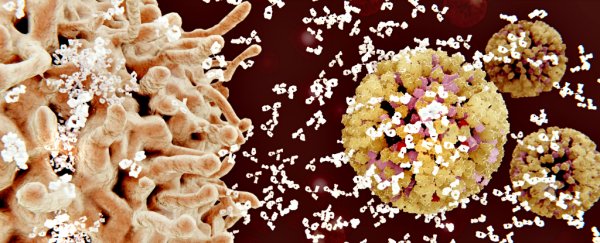A new study has produced an antibody that's able to kill off 99 percent of HIV strains. The protein is made up of three broadly neutralising antibodies, and it is said to be more effective than any naturally occurring antibody that's been discovered.
Research carried out by the US National Institutes of Health (NIH) in conjunction with pharmaceutical firm Sanofi has produced an antibody capable of attacking 99 percent of HIV strains. The International Aids Society has heralded the finding as an "exciting breakthrough".
The human body has difficulty fighting HIV because of the way that the virus changes and mutates — a single patient can have numerous unique strains of the infection present in their body simultaneously.
However, a slim minority of people who suffer from HIV eventually develop a means of battling back in the form of broadly neutralising antibodies.
These proteins are capable of killing off numerous HIV strains at once, so for this joint study between NIH and Sanofi, researchers set out to find a way to harness this natural defense.
To that end, they combined three unique antibodies to produce a tri-specific antibody. While the most effective naturally occurring antibodies can only target 90 percent of HIV strains, this tri-specific antibody was observed to take on 99 percent.
It was even successful at low concentrations. Furthermore, an experiment in which 24 monkeys were administered with the antibodies and then injected with the virus didn't result in a single infection.
As Sanofi's Gary Nabel told the BBC, "[The tri-specific antibodies] are more potent and have greater breadth than any single naturally occurring antibody that's been discovered."
The next step to putting these powerful antibodies to work is a clinical trial, which is expected to get underway in 2018.
Over the last few decades, we have seen some amazing advances in the fight against HIV. These range from the various treatment methods that are now available to the hugely successful educational campaign that's been carried out in Africa.
Truly, no stone is being left unturned in the search for better HIV treatments. Scientists in South Africa are investigating the case of a nine-year-old child who was seemingly cured of HIV after receiving antiretroviral therapy.
Another study saw researchers look into cows' ability to produce broadly neutralising antibodies with the goal of using them to combat the virus.
With any luck, methodology will continue to improve at a fast pace. At the end of 2015, 36.7 million people around the world were living with HIV/ AIDS, so clearly a lot more work needs to be done.
However, this new research project and others like it could lead to the next level of advancements with regards to the virus.
This article was originally published by Futurism. Read the original article.
